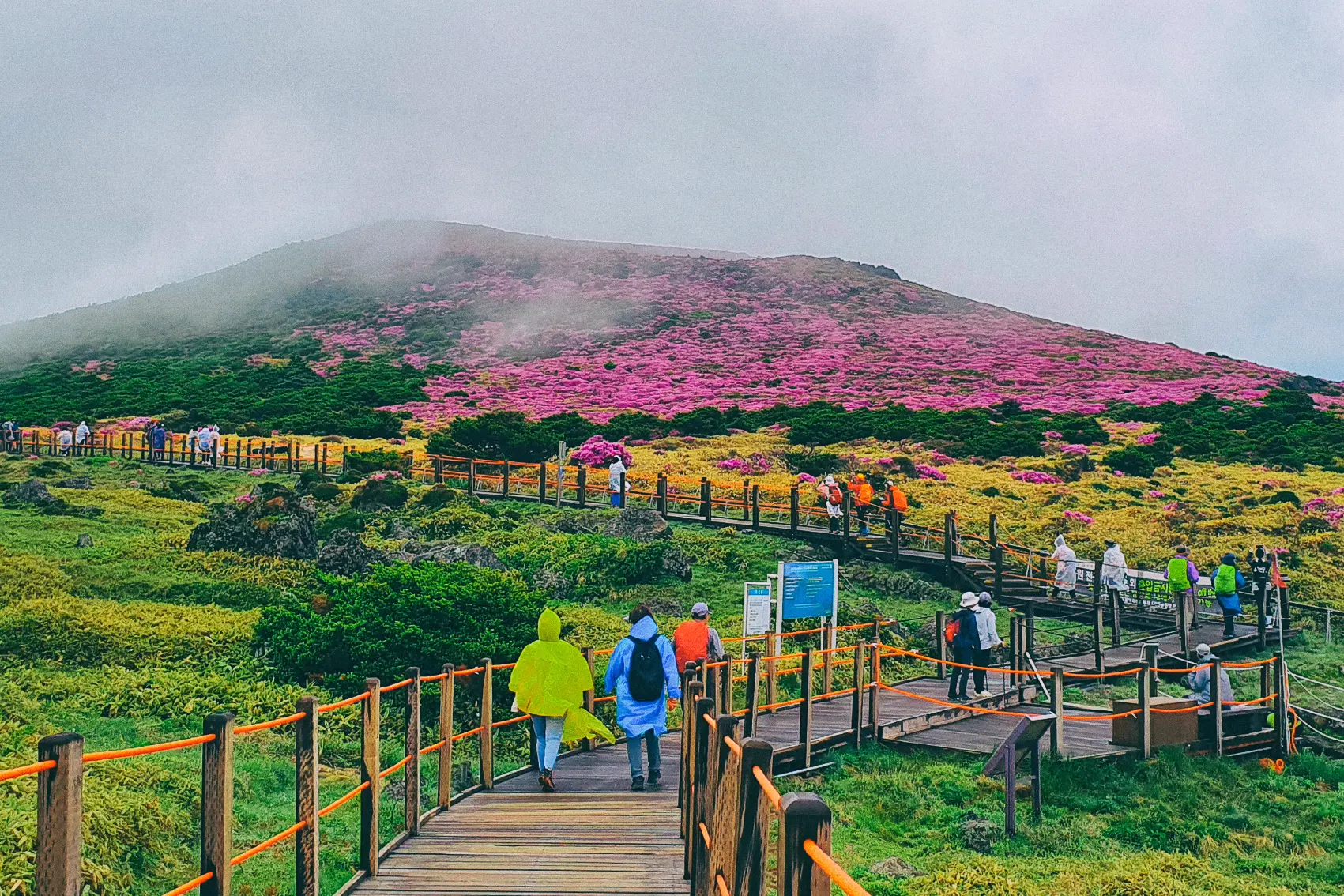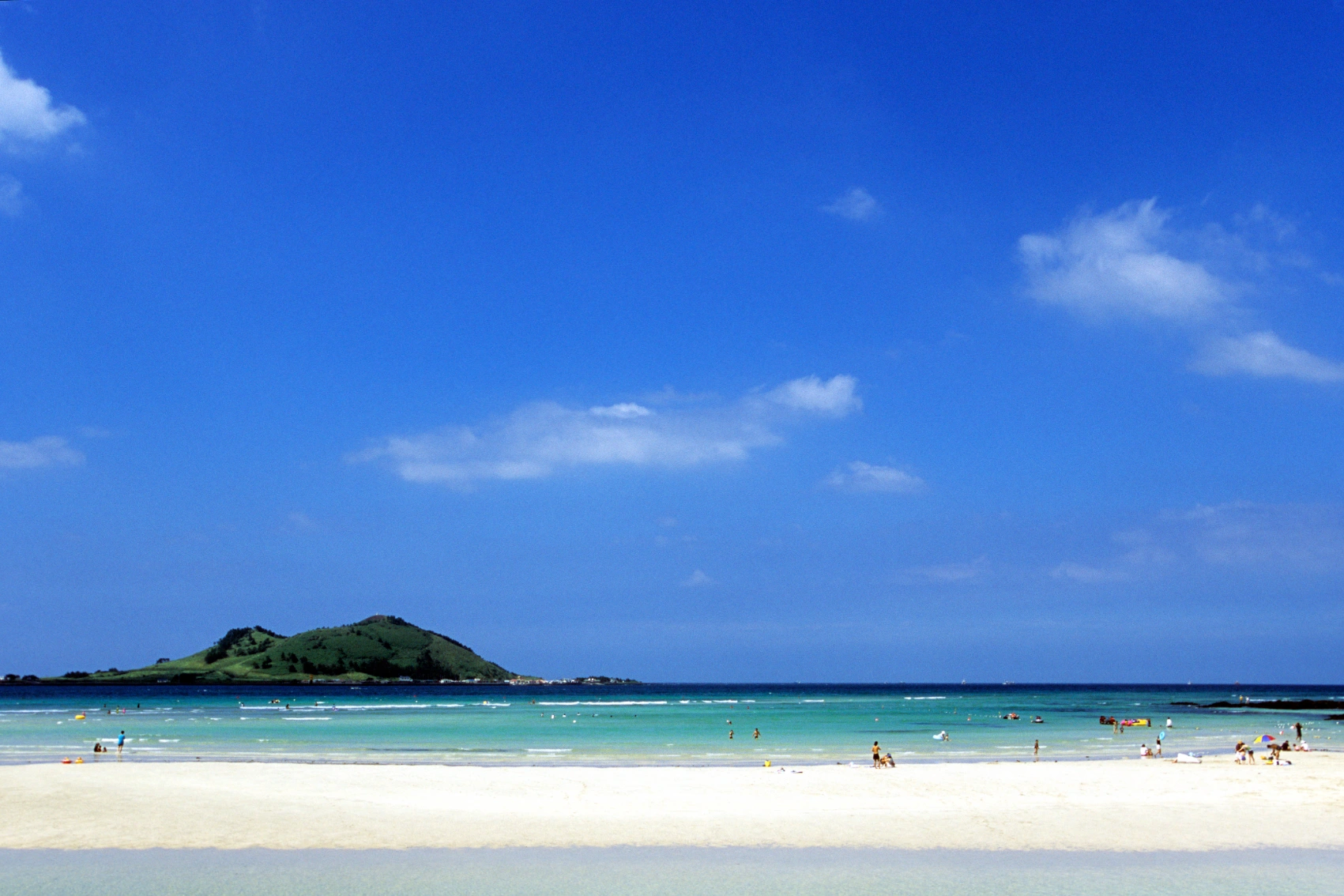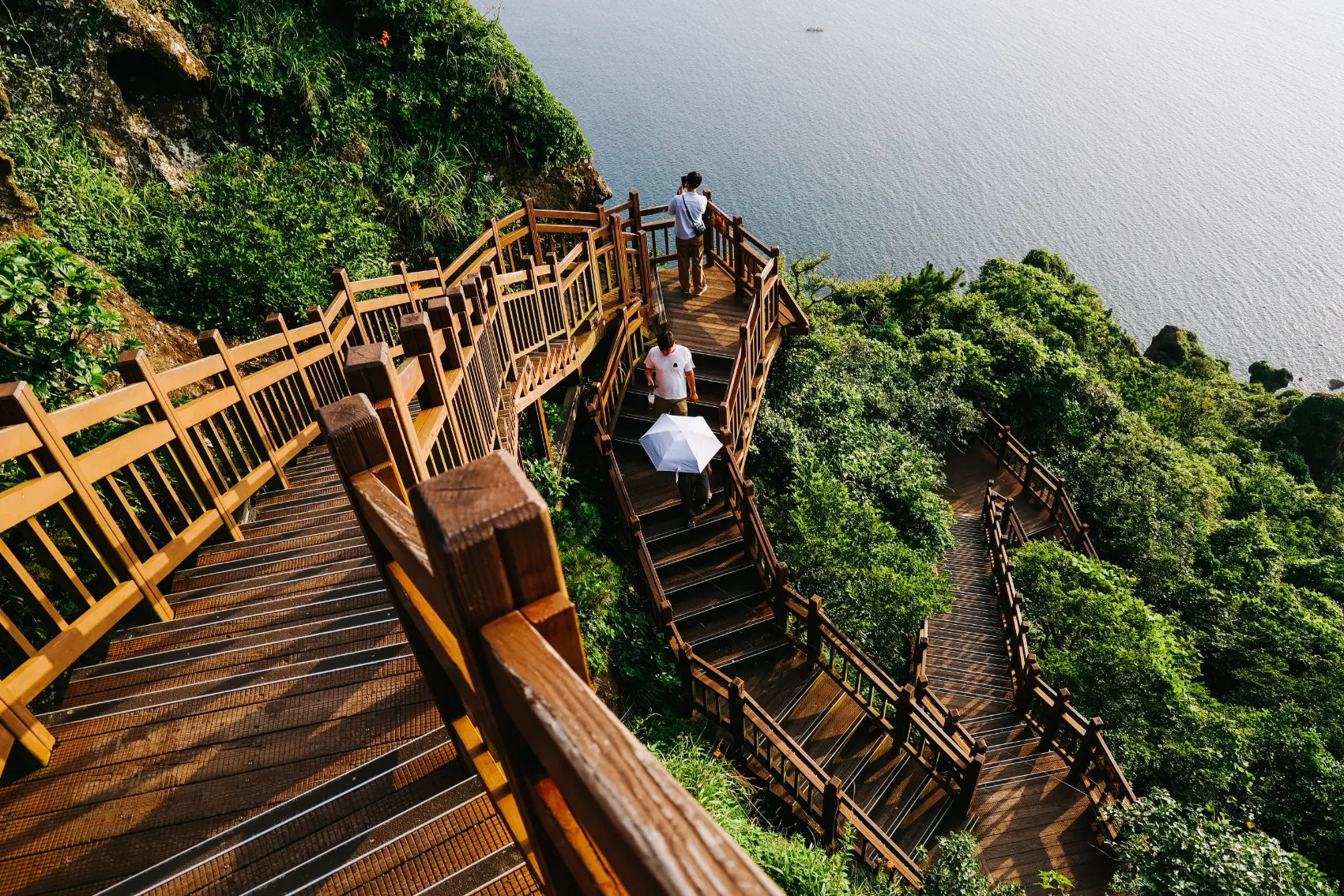Located off the south coast of South Korea, Jeju is the largest island in South Korea, a volcanic landscape with tons of sandy beaches, fishing villages, and lush interior rainforests. This Jeju Island travel guide introduces the island’s highlights, whether you’re chasing views from a volcanic peak, stretching out on a beach, or tasting the famous local seafood and black pork. We’ve rounded up the best things to do in Jeju Island, along with advice on when to go, what to eat, where to stay, and how to get around this Korean tropical paradise.
Best time to visit Jeju Island
When to visit South Korea depends on your interests, but the best time to visit Jeju Island is in spring (April to early June) and fall (September to early November). These times of the year are the most comfortable seasons, with moderate temperatures, clear skies for hiking, and seasonal festivals. Summer on Jeju Island is busy and beach-focused, but it’s also humid and prone to heavy rain, so plan for a mix of sunshine and sudden showers. Winter is quieter, and while the coast stays mild, Hallasan, the volcanic mountain that dominates much of Jeju Island, often gets snow, turning the peak into a striking backdrop for cold-weather hikes.

Top things to do on Jeju Island
The many things to do on Jeju Island include nature and culture in equal measure. Hiking the island’s main peak, Hallasan, offers expansive island views, or you can venture into Manjanggul Lava Tube to explore its volcanic heart. Jeju's outdoor adventures also include walking the long-distance Olle Trail, sea kayaking along the coast, and chasing waterfalls like Cheonjiyeon and Jeongbang. Away from the trails, Jeju Folk Village and the Haenyeo Museum give insights into the island’s famed female divers. Food is part of the experience, too, with black pork barbecue, abalone stew, and fresh tangerines among the local specialties.
Experience it for yourself on: Essential Korea
Explore Jeju Island’s beaches
Jeju Island's beaches are some of the best things to do in South Korea. They come in all styles, so it’s easy to match a stretch of sand to your vibe. Hyeopjae Beach is popular for its white sand and turquoise shallows, which are perfect for swimming or relaxing with a snack. At Jungmun Beach, the stronger waves and lively atmosphere are especially popular with surfers. Families tend to head to Hamdeok Beach, and if you’d rather have some sand to yourself, Iho Tewoo Beach near Jeju City is quieter.

Experience it for yourself on: Seoul to Osaka: Beaches & Big Cities
Must-visit Jeju Island attractions
Jeju Island’s attractions range from natural wonders to cultural landmarks. Seongsan Ilchulbong, or Sunrise Peak, is a UNESCO World Heritage-listed volcano on the eastern side of the island. Visit at sunrise when the crater rim glows. Easy-to-reach waterfalls Cheonjiyeon and Jeongbang cascade through Seogwipo, the island’s second-largest city.
Jeju’s museums and cultural sites give travellers a fuller sense of the island’s history and identity. Try Jeju Folk Village, an open-air living museum with preserved thatched houses, or Jeju National Museum for artifacts tracing the island’s history. Art lovers should stop by the Jeju Museum of Contemporary Art, and all visitors will enjoy the Haenyeo Museum, where you can learn about the lives of Jeju’s remarkable women freedivers.
Experience it for yourself on: South Korea Explorer
Best hiking trails on Jeju Island
Jeju’s hiking trails cover everything from half-day walks to serious climbs, with options for all fitness levels. South Korea’s highest peak, Hallasan Mountain, is the ultimate challenge, with trails leading to crater lake views. The 437km-long (271.5 mi) Olle Trail network circles the island in 21 connected segments, each about 16km (10 mi) long, letting you choose between short coastal strolls or tackling the full long-distance trek. If you prefer something easier, Sangumburi Crater is reached via a level path that leads to panoramic views inside a volcanic bowl. Or you can "hike" down into one of the lava tubes, like Manjanggul, one of the largest in the world.

Discover Jeju’s volcanic landscapes
Jeju’s volcanic landscapes have been shaped by its main volcano, Hallasan, which is surrounded by several hundred smaller satellite volcanoes. Though they are technically live volcanoes, Jeju has not seen an eruption in more than 1,000 years, so exploring this volcanic landscape is safe. Seongsan Ilchulbong’s tuff cone rises dramatically from the sea in cliffs where people often watch the sunrise. You can follow a walking path around Sangumburi Crater, whose caldera fills with seasonal grasses, and underground, you can explore the Geomunoreum Lava Tube System, including Manjanggul Cave, to learn how molten lava carved these long, cathedral-like passages. Jeju’s black volcanic rock beaches and jagged coastal cliffs are daily reminders of the ancient eruptions that created the island.
Experience it for yourself on: Journeys: Soul of South Korea
Sample the best Jeju food
A proper Jeju food guide always starts with the island’s famed black pork, which comes from the native Jeju black pig. It's usually barbecued or grilled at your table until crisp and smoky. Jeonbok juk is another Korean food favourite, a simple, savoury rice porridge with locally caught abalone. Seafood is everywhere, from spicy kimchi stews to sashimi made with fish just pulled from the water. For something sweet, Jeju is known for its special variety of tangerines, which are often freshly juiced or made into chocolates or sweets. Snacking your way through a night market is a must-do for foodies. Try Dongmun Market in Jeju City or Seogwipo Maeil Olle Market in the south of the island.

Experience it for yourself on: Korea to Japan: Epic Eats & Bright City Lights
Family-friendly activities in Jeju
Jeju Island has lots of activities to keep the young and young-at-heart happy. Head to the Teddy Bear Museum to check out its lovable collection of stuffed bears (and take one home from the gift shop), and learn about aquatic life at Aquaplanet Jeju, the largest aquarium in East Asia, with some 45,000 marine creatures. Families also enjoy gentle walks to waterfalls like Cheonjiyeon or spending time at Hallim Park, a landscaped garden filled with caves, bonsai trees, and birds. Jeju Island has several family-friendly beaches, such as Hamdeok, which is shallow and safe for paddling and swimming.
Where to stay: accommodation tips
Where to stay on Jeju Island depends on what you want out of your trip. Jeju City is a good base for shorter stays, convenient for transport and close to the airport and ferry terminal. Seogwipo, on the southern coast, is best if you want to be near nature, with easy access to waterfalls, hiking, and the Olle Trail. The resorts in Jungmun on the southwest side of the island are well-positioned for beaches, while smaller guesthouses and hostels provide affordable, social options. Book accommodations early if you're visiting between May and September or during big festivals, such as the Fire Festival in March, because hotels on Jeju can fill up fast.
Getting around Jeju Island
Getting around Jeju Island is easy, either in a rental car or by public transport, which includes buses and taxis. Tours of Jeju Island help fill the gaps for travellers who don’t want to drive. A rental car is best if you want to explore the more remote hiking trails, beaches, and villages. Buses connect major attractions, but routes can be slow and schedules are limited, so they work best if you’re not in a hurry. Taxis are available in towns, but less so in rural areas. You can also sign up for organized day tours and nature trips, which often include round-trip transportation.
Plan your Jeju Island travel itinerary
A Jeju Island travel itinerary can be as short as a long weekend or stretch into a full week. In three days, you could watch the sunrise at Seongsan Ilchulbong, walk a section of the Olle Trail, visit Cheonjiyeon Waterfall, and try black pork barbecue and night markets in Jeju City. With five days, add a Hallasan hike, explore Manjanggul Lava Tube, and spend an afternoon at Hamdeok Beach. A full week allows you to slow down, incorporating Jeju Folk Village, a couple of museums in Seogwipo, and a side trip to Udo Island for cycling and peanut ice cream.

Experience it for yourself on: Uncover Korea: K Pop & Hanok Villages
Jeju Island in three days
Day 1: Seongsan Ilchulbong sunrise, Manjanggul Lava Tube, Dongmun Market
Day 2: Hallasan hike, black pork barbecue dinner
Day 3: Cheonjiyeon and Jeongbang waterfalls, Hamdeok Beach
Jeju Island in five days
Days 1-2: As above
Day 3: Jeju Folk Village, Seopjikoji coast walk
Day 4: Jungmun Beach, Oedolgae Rock, Cheonjeyeon Waterfall
Day 5: Udo Island day trip for cycling and peanut ice cream
Jeju Island in one week
Follow the five-day plan and add:
Day 6: Olle Trail near Seogwipo, Aquaplanet Jeju
Day 7: Hyeopjae Beach, Jeju Museum of Contemporary Art























